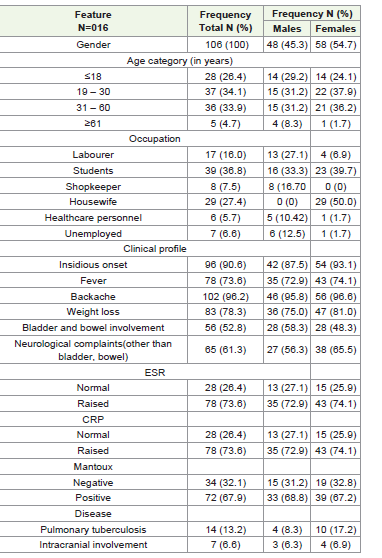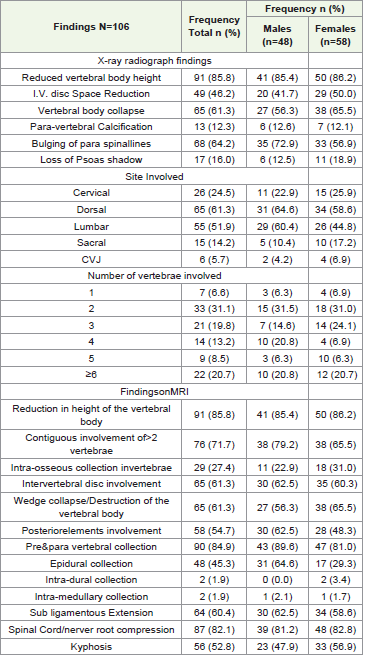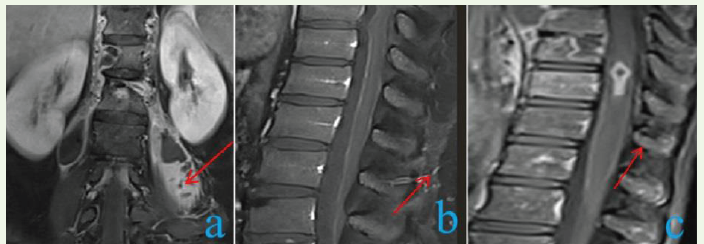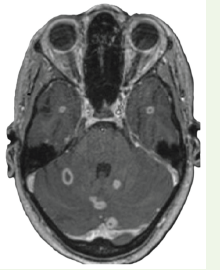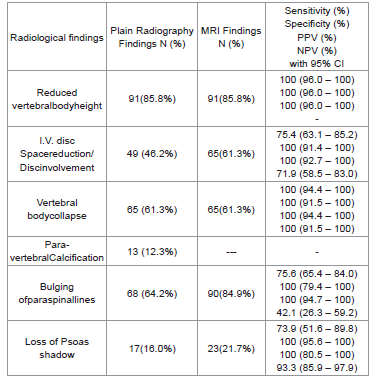Research Article
The Role of Magnetic Resonance Imaging in the Evaluation of Tubercular Spondylitis
Ahmad F1, Kataria B2* and Anil Taneja3
1Department of Radio diagnosis, Atal Bihari Vajpayee Institute of Medical Sciences and Dr. Ram Manohar Lohia Hospital, New Delhi, India.
2Senior Resident, Department of Radio diagnosis, Atal Bihari Vajpayee Institute of Medical Sciences and Dr. Ram Manohar Lohia Hospital, New Delhi, India.
3Department of Radio diagnosis, Atal Bihari Vajpayee Institute of Medical Sciences and Dr. Ram Manohar Lohia Hospital, New Delhi, India
2Senior Resident, Department of Radio diagnosis, Atal Bihari Vajpayee Institute of Medical Sciences and Dr. Ram Manohar Lohia Hospital, New Delhi, India.
3Department of Radio diagnosis, Atal Bihari Vajpayee Institute of Medical Sciences and Dr. Ram Manohar Lohia Hospital, New Delhi, India
*Corresponding author:Bhavya Kataria, Department of Radio diagnosis, Atal Bihari Vajpayee Institute of Medical Sciences and Dr. Ram Manohar Lohia Hospital, New Delhi, India. Email Id: nono_5333@yahoo.co.in
Copyright: © 2024 Ahmad F, et al. This is an open access article distributed under the Creative Commons Attribution License, which permits unrestricted use, distribution, and reproduction in any medium, provided the original work is properly cited.
Article Information:Submission: 08/08/2024; Accepted: 26/09/2024; Published: 30/09/2024
Abstract
Background:Tuberculous spondylitis [TS], also known as Pott disease, affects the spine and can cause severe damage if not diagnosed early. In countries like India, TS is a major health concern due to its high prevalence.
Purpose:The study aimed to determine the role of Magnetic Resonance Imaging [MRI] in evaluating TS and compare the diagnosis with X-ray for evaluating the TS manifestations.
Materials and Methods:A cross-sectional observational study was conducted at Department of Radio Diagnosis at ABVIMS and Dr. RML Hospital, New Delhi, enrolling 106 subjects who presented TS. The subjects were clinically and biochemically evaluated for TS, followed by radiological and MRI assessments.
Results:The most common symptom was insidious onset backache, observed in >90% of cases. Elevated ESR and CRP levels were found in about ~74% of subjects and a positive Mantoux test in 67.9%. Reduced vertebral body height was seen in >85% of cases, irrespective of their gender. Para-vertebral calcification and loss of Psoas shadow were observed in only 12% and 16% of subjects, respectively. Epidural collection was more common in females than males [29.3% vs. 64.6%], and intra-medullary collections were rare [1.9%]. X-ray imaging was highly sensitive [100%] and specific [100%] in identifying the reduction in vertebral body height, vertebral body collapse, and para vertebral calcification to MRI.
Conclusion:Although MRI is the preferred method for accurate diagnosis and management of TS, X-ray can serve as a costeffective alternative for early detection in developing countries such as India.
Purpose:The study aimed to determine the role of Magnetic Resonance Imaging [MRI] in evaluating TS and compare the diagnosis with X-ray for evaluating the TS manifestations.
Materials and Methods:A cross-sectional observational study was conducted at Department of Radio Diagnosis at ABVIMS and Dr. RML Hospital, New Delhi, enrolling 106 subjects who presented TS. The subjects were clinically and biochemically evaluated for TS, followed by radiological and MRI assessments.
Results:The most common symptom was insidious onset backache, observed in >90% of cases. Elevated ESR and CRP levels were found in about ~74% of subjects and a positive Mantoux test in 67.9%. Reduced vertebral body height was seen in >85% of cases, irrespective of their gender. Para-vertebral calcification and loss of Psoas shadow were observed in only 12% and 16% of subjects, respectively. Epidural collection was more common in females than males [29.3% vs. 64.6%], and intra-medullary collections were rare [1.9%]. X-ray imaging was highly sensitive [100%] and specific [100%] in identifying the reduction in vertebral body height, vertebral body collapse, and para vertebral calcification to MRI.
Conclusion:Although MRI is the preferred method for accurate diagnosis and management of TS, X-ray can serve as a costeffective alternative for early detection in developing countries such as India.
Keywords:Magnetic resonance imaging; X-ray; tuberculosis; Spondylitis; India; Back Pain
Introduction
Tuberculous spondylitis, also referred to as Pott disease, is a
type of tuberculosis that predominantly impacts the spinal column.
Tuberculosis (TB) is caused by Mycobacterium tuberculosis and
primarily affects the lungs. However, it can also spread to other parts
of the body, such as the spine [1]. Globally the incidence of extra
pulmonary tuberculosis has been reported to be 3%, of which skeletal
tuberculosis accounts for~10% cases. Incidentally, being the most
common, TS cases constitute 50% alone of all skeletal cases
[2-4]. Of late, owing to the ‘global migration phenomenon’ and the emergence
of multidrug-resistant strains of Mycobacteriumtuberculosis, TS has
seen a gradual increase in its pervasiveness in the developed countries
posing a significant global health challenge. Based on world health
organization reports, the Southeast Asian region contributed nearly
50% of tuberculosis cases and India alone contributes about 23% of
the global burden of the disease [3,5,6].
While Mycobacterium tuberculosis primarily affects the lungs,
spinal infection is always secondary and is caused by hematogenous
spread from the primary site [7]. There are several clinical
manifestations of spinal TS, and the disease progresses very slowly
[8,9]. The severity of TS is modulated by its location, duration, and
the existence of sequelae such as abscesses, sinuses, deformity, and
neurological issues. Moreover, from the onset of symptoms, the
diagnostic window can last anywhere between two weeks and many
years
[1,10,11]. TS symptoms can exhibit a range of variations, typically
encompassing back pain, stiffness, and a progressive decline in spinal
mobility. As the disease advances, it may result in spinal deformities,
including kyphosis. In more severe instances, compression of the
spinal cord or nerve roots can occur, leading to the manifestation
of neurological impairments like weakness, numbness, or paralysis.
The presence of granulomatous inflammation, accompanied by
lymphocytic infiltration and the appearance of epithelioid cells, is a
defining feature of tuberculosis. This can result in the development
of Langhans-type giant cells, the formation of caseating necrosis in
affected tissues, and the occurrence of cold abscesses. [10,12].
The diagnosis of TS involves a combination and correlations of
clinical evaluation, laboratory tests, and imaging studies. A physical
examination might help assess neurological deficits, spinal deformities,
or tenderness. While as spinal X-rays can reveal recognizable
alterations such as vertebral body collapse or disintegration, the
creation of bone debris, and spinal abnormalities in the later stages of
the disease. However, plain radiographs are poor in the early diagnosis
of TS but are useful in assessing coronal and sagittal alignment [3].
Given its ability to detect the earliest alterations, MRI has become
the imaging approach of choice for detecting TS [13]. MRI scans of
the spine produce precise pictures that make it possible to assess the
afflicted vertebral bodies, spinal cord, and encircling tissues [14]. It
can be useful in determining the disease’s severity, the compression
of the spinal cord, and the existence of abscesses.
India is a diverse country that contributed significantly to the
global tuberculosis burden [15]. The TS is one of the significant
contributors to the resurgence of TB in India. The access to high
throughput diagnostic tests like CT MRI to a significant proportion of
the population is limited [16]. Moreover, there is a paucity of studies
related to MRI evaluation of TS. Therefore, the current study aimed to
determine the role of MRI in the evaluation of TS and compared the
diagnostic efficacy of MRI and X-ray in evaluating the manifestations
associated with TS.
Methods
This cross-sectional observational study was conducted at
ABVIMS and Dr. RML Hospital in New Delhi from January 2021
to May 2022. The study included all patients who were referred
for MRI evaluation due to clinical suspicion of TS, based on their
clinical, laboratory, or X-ray findings. Nevertheless, individuals who
had certain conditions or circumstances that made them unsuitable
candidates for MRI were not included in the study. These included
individuals with cardiac pacemakers, cochlear implants, orthopaedic
metallic implants, metal dental implants, magnetic foreign bodies,
claustrophobia, or those who declined to participate. Each patient
underwent imaging procedures to capture detailed images of the
involved spine. This included anterior to posterior and lateral
radiographs, as well as MR images using conventional MR sequences.
The MR images were taken at 3.0 T MRI and included T1 weighed,
T2 weighed, and STIR sagittal sequences, as well as T1/T2 axial
sequences. Additionally, post-contrast T1 fat suppressed sagittal
and axial sequences were obtained. These imaging procedures were
performed by trained radiographers/technicians at the institute.
The imaging findings were compared to the results of clinical and
laboratory investigations, such as the erythrocyte sedimentation rate
(ESR), C-reactive protein (CRP), Mantoux test, and X-ray findings.
Prior to their participation in the study, all patients provided informed
written consent. The study underwent a thorough review and received
approval from the institutional ethics committee. The X-ray and MR
imaging procedures were conducted using the Siemens MULTIX
Intact fixed X-Ray Machine and Siemens 3T Magnetom Skyra, both
of which are manufactured in India.
Statistical analysis:
The data were entered in Microsoft Excel and then analyzed
and statistically evaluated using GraphPad Prism [version 8.0.0 for
Windows, CA, USA]. Continuous data were expressed by mean
and standard deviation while categorical data was presented in
percentage. The sensitivity and specificity of radiological findings in
detecting the manifestations of TS were estimated while taking MRI
as a reference. A two-tailed p-value of the magnitude of <0.05 was
considered statistically significant.Results
A total of 106 subjects who presented TS were recruited in the
current study. The mean age ±SD of all the subjects was 29.9±15.1
years. The demographic, clinical, and biochemical profiles of the
subjects recruited in the current study are presented in [Table 1].
We observed a marginal overrepresentation of females over males
[ratio: 1.2:1] who presented TS in our cohort with the majority of them
working as labourers [27.1%]. The disease was more pervasive among
students as well [37%]. More number of cases were in the age group of
19-60 years in both genders. The insidious onset and backache were
Table 1:Demographic, clinical, and biochemical profile of the subjects with
tuberculous spondylitis recruited in the current study stratified by gender
the most common symptom in nearly all the subjects [>90%] while
as bladder and bowel involvement was reported by 52.8% of subjects.
The ESR and CRP were raised in 73.6% of subjects and the elevation
was independent of the gender. A positive Mantoux tuberculin test
was reported by 67.9% of subjects while pulmonary tuberculosis and
inter-cranial involvement was reported in 13% and 75% of subjects
respectively. Upon radiological assessment, reduced vertebral body
height was seen in most of the patients [>85%] irrespective of their
gender. The para-vertebral calcification and loss of Pso as shadow
were seen in only 12% and 16% of subjects respectively. Unlike cranio
vertebral junction [CVJ] [5.7%], the dorsal [61.3%] and lumber
vertebrae [51.9%] were common sites involved. Most of the subjects
were found to have 2-4 vertebrae involved while 22% of subjects had
more than 6 vertebrae involved with TS [Table 1]. When the patients
were subjected to MRI, a reduction in the height of the vertebral
body was more than 85% of subjects in both genders, followed by
pre/para vertebral collection [84%] and Spinal Cord/ nerve root
compression[82%]. While epidural collection was more common in
females than males [29.3% vs. 64.6%], intra-medullary collection was
the least common finding [1.9%] seen in our cohort [Table 2].
The representative X-ray radiographs and MR images depicting
various manifestations of TS are presented in [Figure 1,2]
and [Figure 3].
Upon assessing the sensitivity and specificity of the X-ray vs.
MRI in determining various manifestations associated with TS, we
observed that both approaches were highly sensitive and specific in
identifying the reduction in vertebral body height and vertebral body
collapse. Nonetheless, we observed that X-ray imaging was specific
enough to identify inter-vertebral space reduction, [sensitivity:
75%; specificity 100%], disc involvement vertebral body collapse
[sensitivity: 74%; specificity 100%] and loss of Psoas shadow [Table 3].
Both positive and negative predictive values were high for all the
parameters evaluated.
Figure 1:[a-d].Spinal tuberculosis with pulmonary involvement, [a]: MR sagittal T2WI, [b]: coronal T2W TIRM:turbo inversion recovery [c]: sagittal T1W FS post contrast, and [d] axial T1W FS post contrast images show T2/TIRM hyperintense pre and paravertebral collections showing subligamentous spread extending from D1 to D7 vertebrae with contiguous involvement of vertebral bodies. Angular kyphosis is noted at D5- D7 vertebral level with anterior wedge collapse of D6 vertebral body with compressive myelopathy at this level. Tuberculous infiltrate in the right upper lobe is identified.
Figure 2: [a-c]MR Images of patients with spinal tuberculosis. [a]: MR coronal T1W FS post gadolinium image shows peripherally enhancing bilateral psoas muscle abscesses with heterogeneous enhancement of visualized vertebral bodies in a patient of tuberculous spondylitis. [b]: In a patient of tuberculous spondylitis, MR sagittal T1W FS post contrast image shows leptomeningeal enhancement of the spinal cord. [c]: MR Sagittal T1W FS post contrast shows intramedullary ring enhancing lesion within the central cord at D9-D10 intervertebral disc level with enhancement of the vertebral bodies and associated pre and paravertebral collections.
Figure 3:Brain Axial T1W FS post contrast image shows multiple, discrete
as well as conglomerated ring enhancing lesions in cerebral and cerebellar
parenchyma suggestive of tuberculomas.
Discussion
In this study, a group of 106 individuals with TS were selected to
examine the effectiveness of MRI in assessing TS. It is evident that
MRI is the preferred diagnostic tool for evaluating patients with TS
due to its numerous benefits in accurately assessing the extent and
seriousness of the condition. Nevertheless, despite some limitations,
X-Ray remains a cost-effective diagnostic tool that is readily accessible
to patients who lack access to more advanced imaging techniques
such as MRI, particularly in developing nations like India.
The studies evaluating the pervasiveness of TS among men and
women have shown mixed results. Some studies have seen men to be
more susceptible to TS [17,18], while others have observed females to
be more vulnerable to TS [19]. However, some reports did not find any
significant predilection for any of the genders towards TS [20-22]. In
the current study, we also observed a marginal overrepresentation of
females presenting TS. Similar to our results a large recent study also
observed that although men are more susceptible to tuberculosis in
general, women are more affected with TS [23]. However, the role of
gender in determining TS susceptibility is not clear yet and warrants
further investigation.
The mean age of the patients in our cohort was 30 years, suggesting
that TS can affect young subjects as well. An earlier study from India
reported a mean age in their cohort to be 40 years [24]. However, this
earlier study was based on a smaller sample size than ours, suggesting
more replicative studies should be carried out to have a conclusive
understanding on the issue. Besides, in our study, we observed that
most of the patients were in the age group of 19-60 years in both
genders. Earlier studies have also reported a similar trend in the age
of their patient cohorts [24,25]. Shi et al and Yuan et al in their recent
large study also found a higher representation of this age group with
TS [26,27]. However, reports show older patients are more susceptible
to TS [28]. Given this heterogeneity in results, it is likely that TS can
affect all age groups. Moreover, in our study, we found that students,
housewives, and labourers were the most affected groups with TS,
suggesting that the country’s economically productive age group can
also be vulnerable. Besides the pervasiveness of TS among students in
our cohort is an uncommon finding and needs to be replicated and
evaluated in future studies.
Unlike pulmonary tuberculosis, the progression of TS is slow
and insidious with the former often accompanied by sputum,
fever, or night sweating and is often non-specific. But the most
common symptom of TS is back pain, typically localized to the site
of involvement and usually in the thoracic region [29], leading to
misdiagnosis till a later stage of the disease. Similar to earlier reports
the clinical pattern of the disease onset and symptoms reported in this
study is not an uncommon finding [25, 26, 29].
In TS, a relatively early and subtle sign, reduction in vertebral
height is often observed along with the irregularity of the antero
superior endplate. Moreover, a classical appearance with TS,some
irregularity of the anterior vertebral margin is also noticed due to the
sub ligamentous extension. In line with several other studies, we also
observed the involvement of the intervertebral disc in most of the
cases both on MRI and X-ray investigations [30].Upon radiological
examination, we observed the presence of paraspinal abscesses in
a sizable portion of subjects while the frequency was higher upon
MRI. Given the lack of proteolytic enzymes in M. tuberculosis [29],
calcification,a diagnostic indicator of TS, is also seen in vertebral
regions [8]. Of a smaller subset of subjects in our study presented
para vertebral calcification. These observations are not uncommon
findings and have been reported earlier as well [8].
The TS initially appears in the anterior inferior portion of the
vertebral body followed by its spread into the central part of the body
or disk [29]. Similar to earlier reports, in our study we observed that
the involvement of dorsal vertebrae was maximum and CVJ was least
involved [31]. However, Batirel et al [17] found the lumbar region as
the most affected region in their study [32]. Moreover, we observed
that 2 vertebrae were involved in more subjects than a single vertebral
involvement, an atypical presentation of the TS, was seen in few
patients. The likely plausible explanation for the latter is that all these
cases were subjected to an early MRI examination and that infection
had not spread sub ligamentously to the neighboring vertebrae.
Given its advantages, MRI reveals key manifestations associated
with TS such as epidural collection, arachnoiditis, spinal cord
compression/canal stenosis, and cord edema that are crucial for
determining the therapeutic intervention and prognosis in the future.
In our patients,MRI revealed disc involvement, paravertebral abscess
and its extent, and psoas involvement in a significant number of
patients with a better contrast than on an X-ray radiograph. Our
results for these observations are in agreement with the published
literature [30,33]. Moreover, like earlier reports, in the current
study,we did not observe any isolated involvement of posterior
elements in any of the cases [34].
On evaluating the sensitivity and specificity of X-ray vs. MRI, we
observed that the former has reasonable sensitivity and specificity
for detecting various manifestations of TS. Our results show a
reasonably high sensitivity and specificity that reported by Bansal et
al [24]. In contrast to our study, the previous research was conducted
with a smaller sample size. Without a doubt, the benefits of MRI in
visualizing bone involvement and related complications such as nerve
root compression, cord edema, pre- and paravertebral, and epidural
abscesses, make it the preferred imaging technique. Nevertheless,
India is a country of great diversity, with a significant portion of its
population living in rural areas where access to modern healthcare
facilities is limited. In addition, India plays a significant role in the
global burden of tuberculosis. Based on our research findings, it is
recommended to utilize X-ray radiography as the primary method for
early detection in individuals with TS. In addition, the effectiveness
of anti-tubercular therapy [the radiographic findings post ATT] on
these patients can be assessed by examining X-ray results. If necessary,
patients can be referred to tertiary care hospitals for optimal disease
management. However, MRI plays a vital role in evaluating the
effectiveness of a treatment by analyzing the results of previous
post-contrast studies and assessing factors such as the resolution of
abscesses and the decrease in enhancement of vertebral body and
inter vertebral discs.
The primary imaging modality utilized for diagnosing the
condition remains a conventional X-ray radiograph. This investigation
is both cost-effective and easily accessible. Calcification is a critical
diagnostic characteristic of the disease and plays a significant role in
plain X-ray radiographs. Nevertheless, plain radiography does have
some limitations, such as its inability to detect certain early-stage
diseases and conditions like cord edema, small prevertebral and
paravertebral collections, and arachnoiditis.
Conclusion
The study findings indicate that MRI is the recommended and
cost-effective method for accurately diagnosing and treating TS
However, in developing countries such as India, X-ray can also be
a reliable and accurate method for early detection of TS. Further
research is needed to validate our findings through additional studies
with a larger sample size.
Limitations:
The study was conducted at a tertiary referral center, suggesting
that patients with advanced stages of the disease may have been more
prominent than those with early presentations. However, this is not
expected to have influenced the study’s findings. In addition, the
study may also raise concerns about the smaller sample size.Ethics Approval Statement:
The present cross-sectional observational study was conducted
between January 2021 to May 2022 at the Department of Radio
Diagnosis at ABVIMS and RML Hospital, New Delhi. Informed
written consent was taken from all the patients before being enrolled
in the study. The study was reviewed and approved by the institutional
ethics committee.
